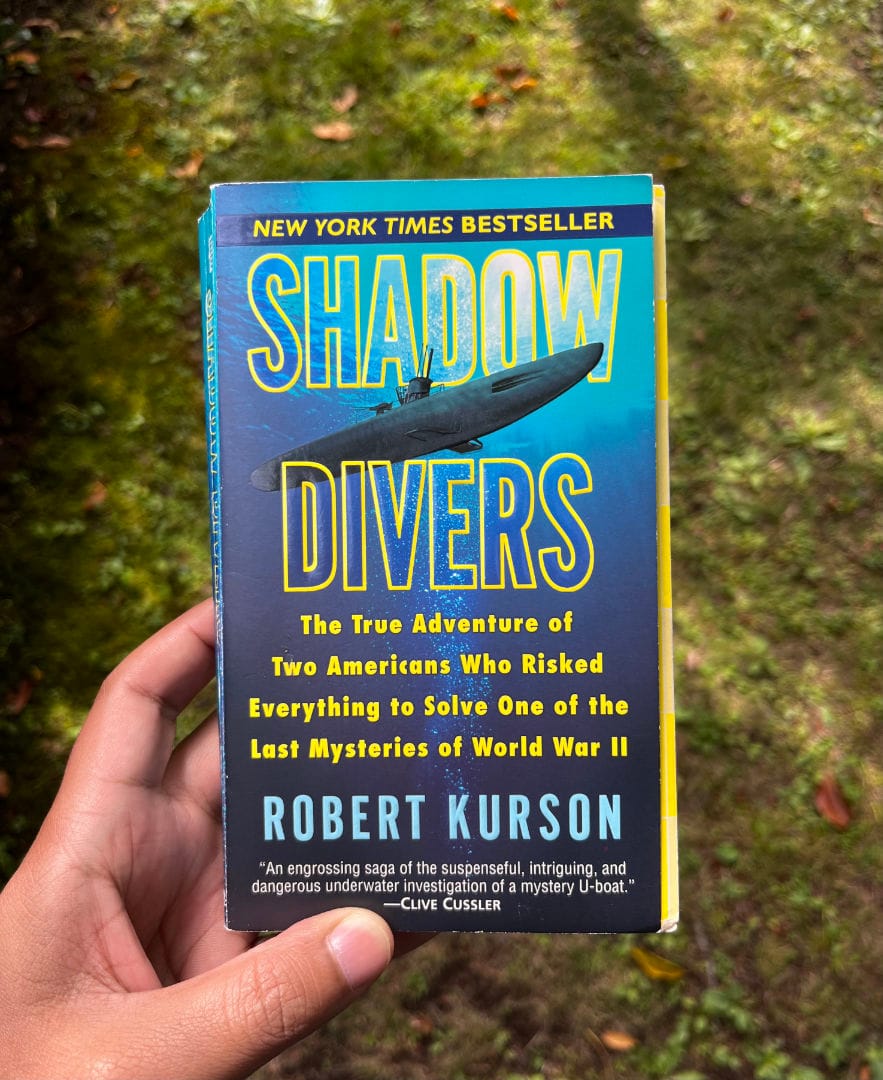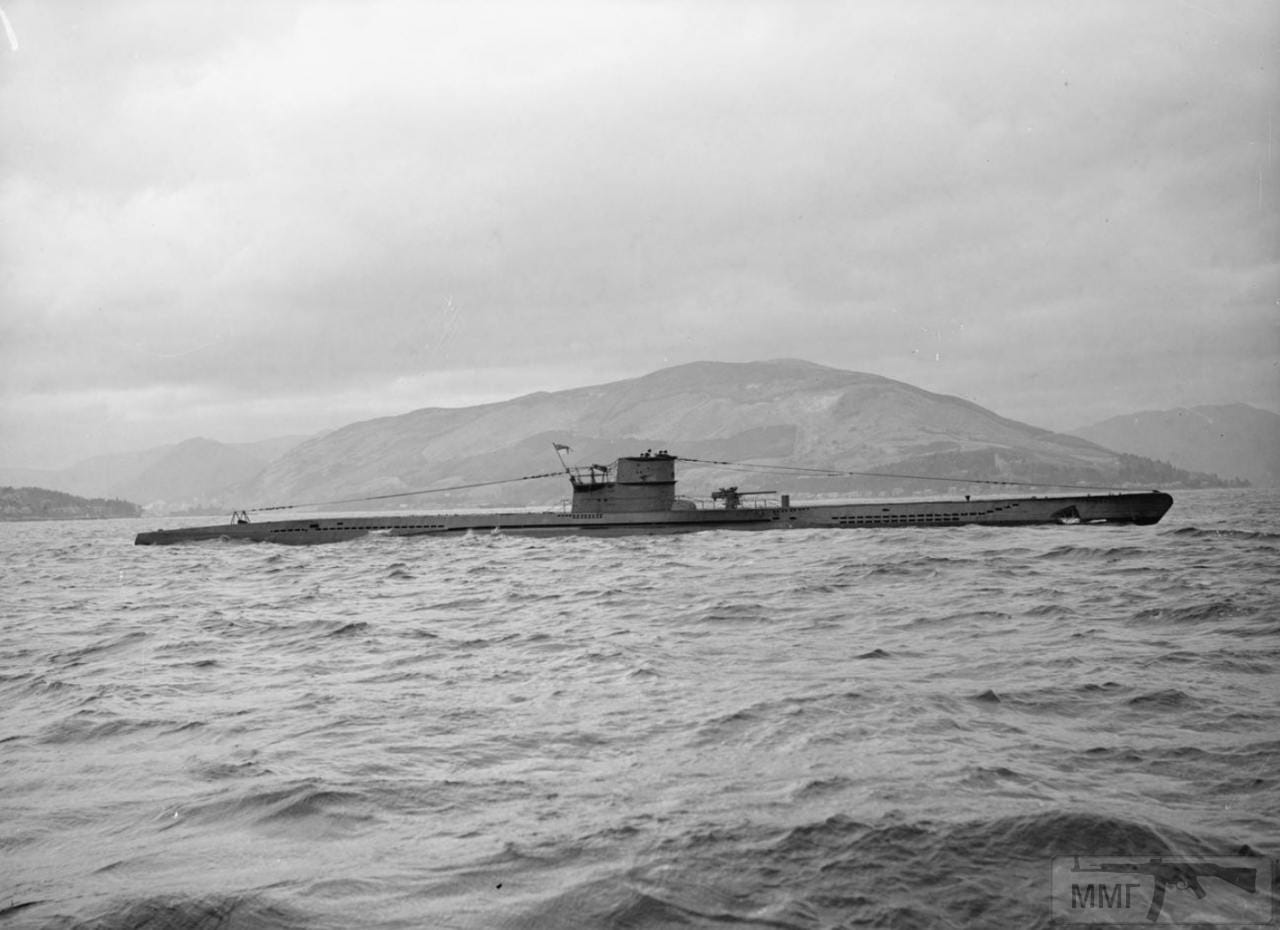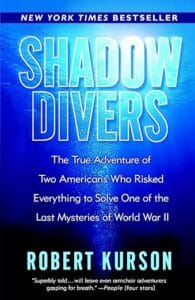It’s not every day you get the chance to rewrite history. But when that moment comes, it demands everything. Shadow Divers tells the story of two Americans who risked their lives to do exactly that.
Ship wreck divers, Richie Kohler and John Chatterton, discover a long forgotten U-boat from World War II, 200 feet deep in the ocean. This amazing true story follows how their enthusiasm for identifying it and honouring the men who battled in that U-boat nearly cost their personal and professional lives.

Summary
An epic find
About 50 miles north of New Jersey, John Chatterton and Richie Kohler, along with their wreck diving crew, discovered an extraordinary wreck roughly 230 feet below the ocean surface. During his limited 20-minute dive at the bottom, Chatterton realized he had stumbled upon a wreck diver’s holy grail: a submarine. Not just any submarine, but a U-boat!
A quick history of U-boats
U-boats were German submarines, most famously used during World War 2. The name comes from Unterseeboot, meaning “undersea boat.” In World War I and especially World War II, U-boats were Germany’s key weapon in the “Battle of the Atlantic,” attempting to cut off Allied shipping by sinking cargo ships and warships. At the height of the Second World War, these were the most feared machines ever on the ocean.
More on U-boats | Battle of the Atlantic
Why was this U-boat an epic find?
The U-boat they discovered was an IXC/40 type: A long-range U-boat.
What made it extraordinary is that no such U-boat was ever listed in the history of this part of the world.

“I gotta say, this is a mystery like you read in a book,” Kohler said. “A German U-boat comes to our doorstep in New Jersey. It explodes and sinks with maybe sixty guys onboard, and no one—no government or navy or professor or historian—has a clue that it’s even here.” (p.196)
But everything comes at a cost
But finding the U-boat was just the beginning. Identifying which specific U-boat it was required multiple visits, and these were far from leisurely dives. Even the most experienced wreck divers would think twice before diving more than once if the wreck is at 230 feet deep because the risk is enormous with every additional foot.
On top of that, both divers had to contend with personal pressures. It’s hard on loved ones when your profession constantly puts you in danger. Yet Kohler and Chatterton pressed on, determined to solve the mystery and honor the people lost aboard the U-boat.
But Kohler and Chatterton were not the ones to give up
The process took years. Both men made personal sacrifices, including strains on their marriages, to see their project through. But their dedication paid off. After months of research and numerous dives, they were able to identify the U-boat and, more importantly, honor the lives lost aboard it. Kohler, particularly driven by his German heritage, was determined to bring justice to the people who served on this German war machine.
Their commitment to honoring the crew
Kurson does a great job of emphasizing that these two men are not just going for a treasure hunt–far from it. In fact, it’s not like they are getting paid for this kind of work. But they did it anyway. And it was driven by their passion for shipwreck diving. But both of their goals changed after Chatterton discovered human bones inside the sub. The men were not rescued. They were lost and forgotten. From that point onwards, their goal was to honour these men.
“For a moment, the divers sat in silence, startled by the finality and similarity of their thinking. Slowly, each explained his reasoning until it became clear that they had arrived at their conclusions for identical reasons. Their discussion lasted for hours. Their resolve pivoted around five principles:
1. Respect for the crewmen.
2. Respect for the families in Germany.
3. Honoring the brotherhood of the deep.
4. Protecting the image of wreck divers.
5. Doing the right thing.(p.219)
Ideas that resonate with me
Shipwreck diving is not a walk in the park
One thing that I was completely oblivious to is the fact that shipwreck diving is a completely different sport from regular diving. It is almost like it’s a different sport–evidently an extremely dangerous one. At 20 feet, it’s just a nice swim beneath the ocean flow, but at 200 feet, it’s pitch black, you are essentially alone, and everything around you screams ‘death’.
The first couple of sections of the book describe the ‘process’ of wreck diving.
When someone is exposed to a water pressure of 200 feet, strange things start happening. First, the amount of nitrogen entering your lungs increases. It changes the whole chemistry of the body. You start seeing things that are not there. Your problem-solving abilities drop dramatically. Even the smallest issue seems like a life-threatening one because your mind is already in panic mode.
“McMahon wondered if he should follow the crabs out to sea. He took a deep breath. He started talking to himself. “I gotta get outta here,” he said. “Crabs are talking to me. When a crab talks, it’s time to go home.”(p.112)
“Even the act of observing another diver in distress can be dangerous while deep in the ocean. A diver’s emotions at 200 feet are already in hyperdrive from narcosis. Should he come face-to-face with a diver who believes he is dying, that diver’s eyes will leap across the water and become his own eyes, and he will see, through that man’s panic, the spectrum of terrible possibilities that lie just around the corner for himself”(p. 30).
“A diver lost or tangled inside a shipwreck has come face-to-face with his maker. Corpses have been recovered inside wrecks–eyes and mouths agape in terror, the poor diver still lost, still blinded, still snagged, still pinned. Yet a curious truth pertains to these perils: rarely does the problem itself kill the diver. Rather, the diver’s response to the problem–his panic–likely determines whether he lives or dies”(p. 35).
For so long, I naively thought that diving is just a symmetrical process. You go down, do your thing, and then come up. Well, how wrong could I be?!
When it’s time to go up, there’s a whole other process that you have to keep in mind. This process is called decompressing. When you go up, the pressure inside your body decreases again. This results in the formation of larger and larger nitrogen bubbles in the bloodstream. If you do not make periodic stops on your way up to let those bubbles dissipate, they will block your bloodstream, and you will be paralyzed or will simply die. Imagine a situation where things went horribly wrong at 200 feet. You still have to calm yourself down and spend about an hour at different heights at the ocean. If you panicked and shot to the surface, you’re already dead–you just don’t know it yet.
“Kohler went ashen at the answer. He remembered the Atlantic Wreck Divers’ mantra: I would rather slit my throat than shoot to the surface without decompressing.”(p.229)
The book reads like a novel
You know a book is good when you have to constantly remind yourself that you are not reading a novel, but a non-fiction book. This book had me hooked from the first page–it reads more like a sci-fi thriller than a non-fiction. Excited to find out that he has more books. I’ll be reading them.
So much research has been done to write this book
Apart from Kurson’s writing skills, I also came to admire the amount of research that went into writing this book. After all, this is a book about not just history but ‘forgotten history’.
Circle-runners
The probable cause of the accident that wrecked the U-boat was determined to be a ‘circle runner’. And it makes sense. Circles runners are the torpidos released from the same submarine that malfunctions and comes back, attacking the mother ship. It’s extremely hard to find a submarine that was destroyed by its own torpedo. Because there are no spectators. You are deep beneath the ocean, and you see an enemy ship. You fire the torpedo, but for some reason, it circles back on your ship. And it hits. There’s no one to witness this event, not even the enemy, because one of the reasons why a torpedo turned against its own sub is that the enemy range is too long in the first place.
“The divers had read about occasions in which a torpedo’s steering system malfunctioned, causing the weapon to reverse direction in the water and head back toward its own submarine. Those derelict torpedoes were called “circle-runners” and had turned on several of their own U-boats.”(p.246)
Parts that left a mark on me
- “When things are easy, a person doesn’t really learn about himself. It’s what a person does at the moment of his greatest struggle that shows him who he really is. Some people never get that moment. The U-Who is my moment. ” (p.314)
- This is the Chatterton thinking process before deciding to go all in on identifying the U-boat. This is why it’s mentioned here as “U-Who”
- “I need to make a decision,” Chatterton said to himself. He flashed through his options; they numbered exactly two. He could turn and leave the compartment. Or he could take another swing at the giant oxygen tank, which he would have to strike on the cap—its most dangerous spot—in order to shake it loose.“If the thing blows, I won’t hear anything,” Chatterton thought. “I’ll be dead and in a billion pieces.“If I leave now, I can leave in one piece.” (p.340)
- This is what makes a good shipwreck diver a seasoned pro. The ability to think clearly at 200 feet.
- “Ultimatums don’t work,” Chatterton said. “Marriages don’t work when one person says, ‘You and I will be fine together as long as you do what I say.’ She wants you to give up diving? That alone shows that Felicia doesn’t understand what you’re made of. Diving is in your soul. How do you ‘agree’ to give up your soul?” (p.307)
- Sometimes, life is just unreasonable. Everybody gets hurt for doing the right thing.
Coffee chat
- Is Shadow Divers a true story or partly fictionalized?
- Yes, it is a true story, not fictionalized. It’s a story based on two shipwreck divers, Richie Kohler and John Chatterton.
- Which U-boat did Chatterton and Kohler discover off the coast of New Jersey?
- They discovered the U-869, a German Type IXC/40 U-boat(That means its design for long range combat). What’s really interesting is that at some point in World WW2, U-869 went AWOL. It was planned to sail to Gibraltar during the period. So that is what you would find in history books–that it was gunned down at Gibraltar. Until Chatterton and Kohler proved otherwise.
- How dangerous is deep wreck diving at 230 feet?
- It is as dangerous as it gets. For instance, you can dive into that depth in a minute. But if you stay at the bottom, say 20 minutes, you have to make frequent stops on your way up for an hour, to keep the nitrogen level of the blood at a constant level. Otherwise, you will get, in deep dive language, ‘bends’. That means the nitrogen will block your bloodstreams, and you will probably not live to tell the tale when you come up. If you’ve seen Mission: Impossible – Dead Reckoning, this is why Tom Cruise had to decompress after surfacing from the submarine.
- Why did the divers risk their marriages and lives for this mystery?
- It mattered to them for many reasons. First, they loved what they were doing. Second, they they felt like this was their chance to do something meaningful.
- What happened to Chatterton and Kohler after the events in Shadow Divers?
- Their lives got better than it was before, rightfully so. Chatterton went on more deep dive adventures and finally settled as an educator. Kurson and Chatterton even co-authored a book. Kohler became a TV personality and narrator. There is a documentary about this whole story as well.
Parts that made me pause and think
- What makes someone risk their life — and even their family — for the sake of solving a mystery?
- The more I think about this, it makes sense to me that how people prioritize certain things is influenced by their personal battles. We all ask the question, ‘What are we doing here?’, ‘What is the meaning of my existence?’ And when the opportunity comes, everything clears, and we see an answer that question. You are ready to win against your own battles, and you see this opportunity as the perfect battleground. So you get to work, no matter what the consequences are.
- How should we honor the dead when they were once “the enemy”?
- This is just an easy question, but worth answering. “They were never the enemy”.
- At what point does passion stop being inspiring and start becoming destructive?
- It seems to me that there is no clear boundary to this. Lives are dynamic. Things change. We are never in an equilibrium. So, trying at least ‘something’ is far better than waiting forever to make a decision. Because they are not going to be perfect anyway.
How did the book change the way I think?
When things are easy, a person doesn’t really learn about himself. It’s what a person does at the moment of his greatest struggle that shows him who he really is. Some people never get that moment.

